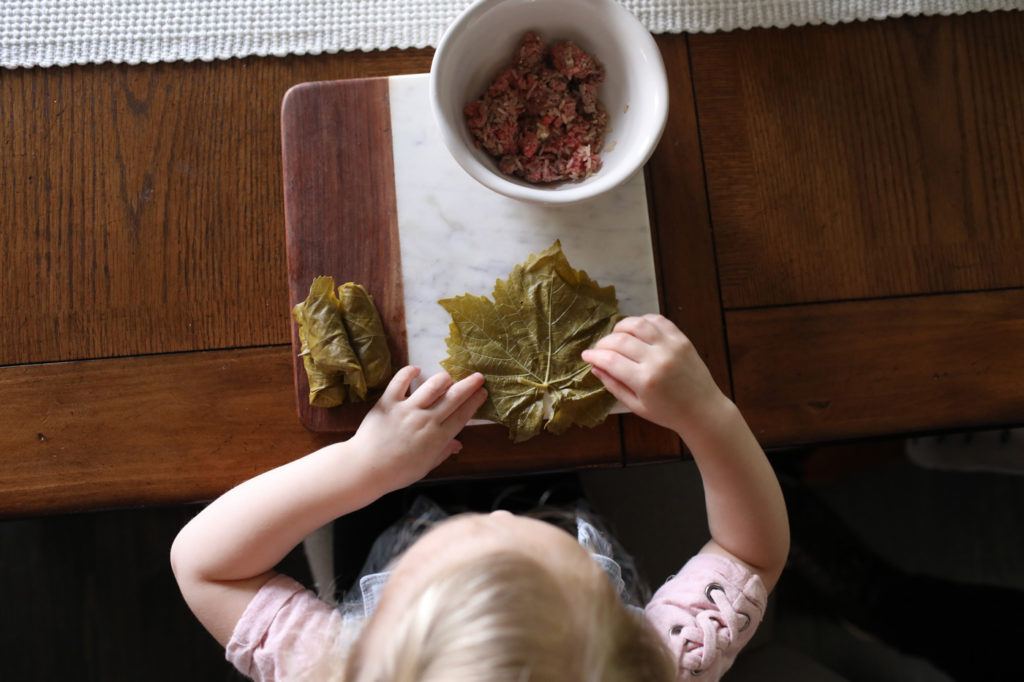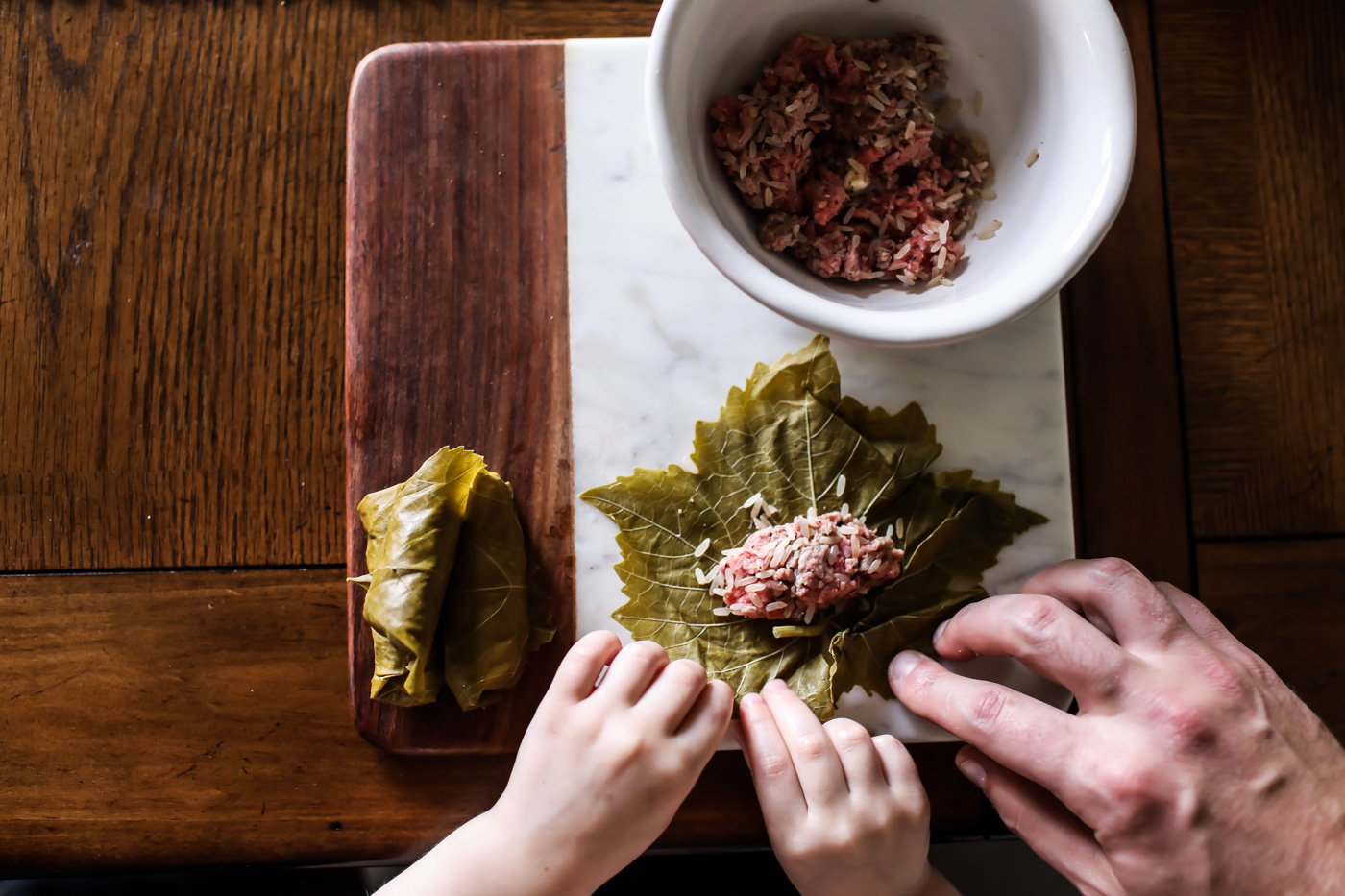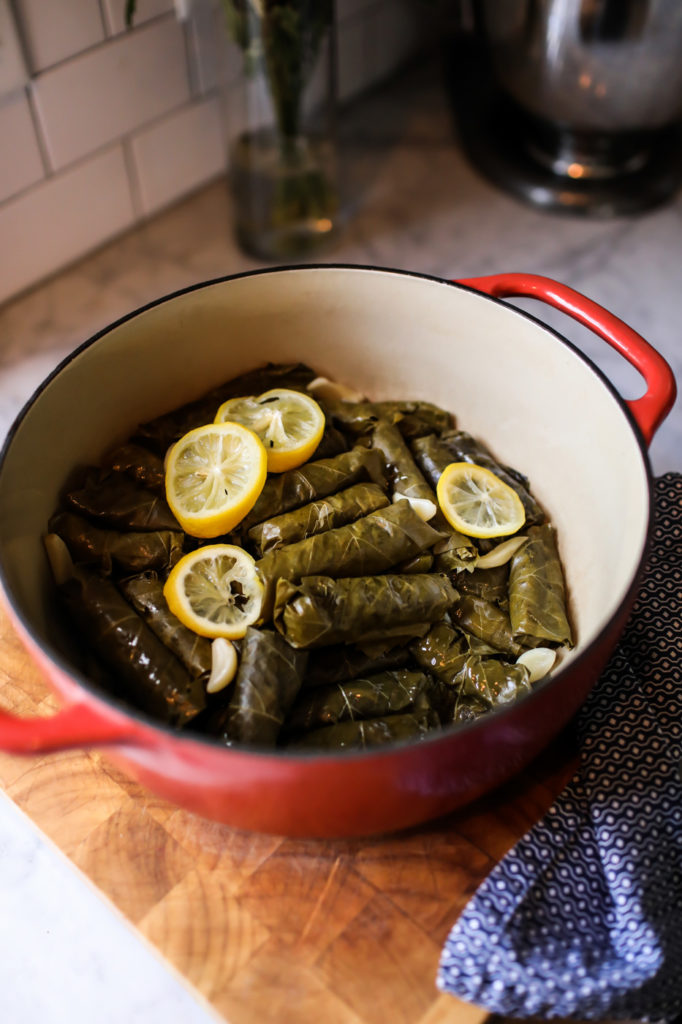“Who makes better grape leaves, Dada or Sitty?”
I pose this question to my two-and-a-half year old, Vivienne, on a near weekly basis. Phone in hand, recording her every response, I already suspect I’m doomed for failure—either by way of sass, truth or genetics. She’ll pause, look me in the eye, and respond, Sitty—followed by a giggle.
I do not send the video to my mom.
I imagine such a debate has existed in my family since the days of the old country. In Arabic, the word Sitt, or Sitto, loosely translates to grandmother, depending on your country, dialect or region. After our family immigrated through Ellis Island to Valdosta, Georgia, from Beirut, the word took on its Americanized moniker. Although she is now gone, I still tell my own mama that my Sitty made the better grape leaves. I suppose it makes me feel better about my own shortcomings.

Colloquially, the rolled concoction is better known in America as dolmades, per the Greeks. But it’s the Lebanese version, in my opinion, that is superior. A filling of rice and meat, rolled into a grape leaf—hence the name—spiced with savory and sweet, and slow poached until cooked firm. How to properly make this item is as fiercely debated amongst the Lebanese as barbecue is to a Southerner. I’ve seen the meat vary from lamb to beef to pork—or sans meat altogether. In some instances, tomato is added, and in others, the stuffed leaves sit atop thick-cut pork chops and onions, to impart even more flavor. But I’m certainly passionate there’s only one way to make a batch of stuffed grape leaves—our way.
I rarely remember a family gathering where my Sitty didn’t spend her early morning hours rolling grape leaves by hand, followed by frying batches of chicken in cast-iron—all in an effort to feed our bellies after feeding our souls at Sunday mass. We kiddos did not eat for free, however. The art of rolling a grape leaf was taught at an early age; if you wanted to eat ‘em, you’d have to roll ‘em.

As soon as Vivienne could tactfully muster the skill to feed herself by hand, we put her to the test. It was her first Thanksgiving, and mama had made a big batch of grape leaves to enjoy alongside some tabbouleh, kibbeh nayyeh, smoked turkey, mashed potatoes, and bacon infused collards. Vivi took one bite of the cigar-shaped beauty and instantly started signing—by knocking her fists together—for more. My heart swelled with pride.
When my wife was pregnant with our first child, I took pride in spending a day or two making up batches of homemade baby foods—baking sweet potatoes and pureeing fruits and other concoctions to freeze until the baby was ready. It felt good to know exactly what we were feeding our child. Yet, in practice, we often had to supplement with store-bought jars of food or “squeezies” on the go.
Although I enjoy cooking fresh, healthy meals nearly every day for my family, my daughters are no stranger to the inside of a fast-food restaurant. In fact, I love it when my wife sternly tells me she “needs a few hours” on a Saturday morning.
Vivienne and I will drive up to our local McDonalds in East Nashville for some daddy-daughter time. There’s always a table of older veterans catching up over coffee—each one smiling and laughing with my daughter when we walk in, with each gentleman reminding me through her sassy behavior and my disciplining, that the days are long, but the years are short. I know the food isn’t great, but man, do I enjoy every part of that experience.



But that shit hit the fan when we had our second daughter, Everly. It’s been nine months and I sadly have never made her one ounce of baby food. Just when you’ve adjusted to the whole parenting routine, the second child sends you into survival mode.
But we are finally starting to find our new normal. We’ve found that eating dinner a bit earlier, and as a family, can actually lower our stress levels. Our kids eat better, more diverse foods—plus I don’t feel like a short order chef cooking up several meals between the hours of five and eight p.m.
During our family meals, our baby Everly might try some homemade hummus, mashed potatoes, or pureed cauliflower. Vivienne is much more likely to eat a piece of grilled chicken with “dunk-dunk,” i.e. homemade tzatziki, if mom and dad are also enjoying. I like to think I’m feeding them the good stuff, without them even knowing it.
But I’m also a strategist; I’ve developed my own technique when it comes to cooking for kids. My wife and I sometimes prefer to skip the family meal altogether, instead putting the kids down early to relish a dinner over Miles Davis and a bottle of wine, without any distractions. On such nights, I like to cook items in stages. I might be prepping for a truffled white cheddar mac n’ cheese, but I’ll stop short of the truffle and serve the hearty dish, as a creamy cheesy pasta, to Vivienne. She loves it.
Once she’s down, I’ll finish the dish by baking everything off and adding truffles, serving the indulgent side along with a quick pan seared pork loin for dinner—and a bottle of wine (or two). Everyone is happy, and I feel like I’ve killed two birds with one stone—making one dish work for the whole family.
Better still, I know the next day, leftovers will be served as they were intended—truffles and all—and I’ll slowly introduce my daughter to new flavors, expanding her palate as she revisits last night’s “cheesy noodles.”


Doctors say kids need to be exposed to a food item ten to twelve times before they’ll likely take it on. I’ve found it takes nearly double said attempts, but I’m happy to report that Vivienne now loves foods like brussel sprouts, roasted broccoli, boiled shrimp, and even crawfish—the gal can down some étouffée! In other words, persistence pays off.
Fortunately, it only took one time with the grape leaves before Vivienne started requesting them for every meal. I love her enthusiasm, but darn, these old country foods take a lot of work to prepare.
So I’m teaching Vivienne with my own hands, in the same way I learned from my mama and my Sitty. A pinch of the rice and meat mixture placed onto the leaf, followed by a tight fold of both ends, and a roll. It takes patience and practice, but she’s getting the hang of things. It’s a tradition I lovingly share.
A few hours later, we’re digging in together, and as a family. The past meets the present, and my teachings mean that the future looks even better.
Damn, that’s the good stuff.

RECIPE
Stuffed Grape Leaves
I like to use an 80/20 ground beef, or a grass fed ground lamb in this recipe. It’s important to thoroughly rinse and squeeze the canned grape leaves prior to rolling, to ensure your moisture ratio when cooking is sufficient.
Ingredients for meat filling
- 1 lb ground beef or lamb
- 1 cup converted white rice
- 4 cloves garlic, minced
- 1 tsp kosher salt
- ½ tsp black pepper
- ½ tsp allspice
- 2 lemons, juiced
- 1/4 cup butter, finely diced
Method
Combine all ingredients into a large mixing bowl and mix thoroughly until well combined. Set aside.
Ingredients for grape leaves
- 1 jar grape leaves, or about 50 to 60 fresh grape leaves
- 15 to 20 cloves garlic
- Lemon slices
- 2 tbsp butter, cubed
- Kosher salt
Thoroughly rinse and dry grape leaves. Add about 10 grape leaves and a few garlic cloves to the bottom of a Dutch oven.
Begin rolling grape leaves by laying the leaves flat, vein side up, onto a hard surface. Add a generous pinch of meat to lower third of the leaf, roll over one time, fold the ends, and finally roll up completely, as in making an egg roll.
Place in the pot, seam-side down side-by-side, alternating layers as you reach the top. Pack the leaves tightly, ensuring an even distribution of garlic cloves amongst the layers. Add a generous sprinkle of salt over the leaves and evenly distribute lemon slices and butter.
Fill the pot with water, just up to the top layer. To keep the leaves from unrolling during the cooking process, place a small plate on top of the leaves. Bring to a slow boil over medium-high heat, cover and reduce heat to simmer, 25 to 30 minutes.
Remove from heat and allow to sit for another 30 minutes before serving.
Everyday Hummus
Although I’m a fan of always soaking my own chickpeas, the reality with kids is that it rarely happens. This is an “everyday” recipe I often put into practice using canned chickpeas. I like to wash them several times in a colander to remove that tinny flavor from the canned beans, removing the outer skin when possible as well. A great tahini, and an extra squeeze of lemon, can help cover up your shortcut of using canned beans.
Ingredients for Hummus
- 1 clove garlic, minced
- 1 tsp kosher salt
- ¼ tsp ground cumin
- 2 cans chickpeas, washed several times and outer skin removed
- ½ cup good quality tahini
- ½ lemon, juiced
- 2 tbsp extra virgin olive oil
- 1 cup water, divided
Method
Add all ingredients into a food processor and mix until combined, adding more water and salt to create preferred texture and taste. For a more traditional hummus, process ingredients by hand using a mortar and pestle.







Our comments section is for members only.
Join today to gain exclusive access.